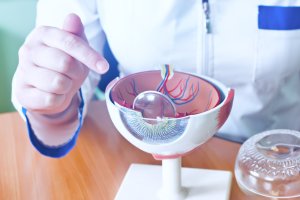The 4 Stages of Diabetic Retinopathy

Voted Best of Berks—
eight years in a row!
Diabetic retinopathy is a progressive eye condition that affects people with diabetes. It can particularly affect those who have had diabetes for an extended period of time, or those who have poorly controlled blood sugar levels. Diabetic retinopathy damages the blood vessels in the retina, which contains light-sensitive cells at the back of the eye responsible for transmitting visual information to the brain. Understanding the 4 stages of diabetic retinopathy is essential for effective management of this potentially sight-threatening disease.
1. Stage 1: Mild Nonproliferative Diabetic Retinopathy (NPDR): In the initial stage of diabetic retinopathy, mild nonproliferative diabetic retinopathy (NPDR), the tiny blood vessels in the retina, known as capillaries, start to weaken and develop microaneurysms. Microaneurysms are small bulges in the blood vessel walls that can leak small amounts of blood or fluid into the retina. At this stage, individuals with diabetes may not experience any noticeable changes in their vision, and the condition is typically asymptomatic.Early detection is crucial during this stage, as it provides an opportunity to implement strict blood sugar control and other diabetes management strategies to slow or prevent the progression of diabetic retinopathy.
2. Stage 2: Moderate NPDR: As diabetic retinopathy progresses to the moderate stage, more significant changes become apparent. In moderate NPDR, a greater number of blood vessels become blocked, reducing the blood supply to the retina. This leads to the development of cotton wool spots, which are soft, fluffy white patches on the retina caused by damage to nerve fibers. Hemorrhages may also occur, resulting in small, scattered spots of bleeding within the retina.People with moderate NPDR may begin to experience mild visual symptoms, such as blurred or fluctuating vision, difficulty focusing, or problems with color perception. It is crucial for individuals at this stage to work closely with their eye care professionals to monitor the condition and implement appropriate interventions, such as laser treatment or medication.
3. Stage 3: Severe NPDR: Severe nonproliferative diabetic retinopathy (NPDR) is characterized by the worsening of retinal blood vessel damage and a significant reduction in blood supply to the retina. At this stage, a more extensive area of the retina becomes oxygen-deprived, leading to the release of chemicals that stimulate the growth of new blood vessels, a process called neovascularization. These new, fragile blood vessels can leak blood or other fluids into the vitreous gel inside the eye, causing floaters or a sudden decrease in vision.Severe NPDR is a critical stage that requires prompt intervention to prevent further vision loss. Laser therapy, also known as photocoagulation, is often used to seal leaking blood vessels and reduce the risk of complications like diabetic macular edema or proliferative diabetic retinopathy.
4. Stage 4: Proliferative Diabetic Retinopathy (PDR): Proliferative diabetic retinopathy (PDR) is the most advanced and severe stage of diabetic retinopathy. In PDR, the abnormal growth of fragile blood vessels continues, but these new vessels are highly susceptible to bleeding and scarring. These blood vessels can also contract and cause retinal detachment, a serious condition that can lead to complete vision loss if not treated promptly. Vision can be severely compromised in individuals with PDR, and they may experience sudden, profound vision loss or see a shower of floaters due to vitreous hemorrhage. Treatment for PDR often involves laser surgery or other advanced procedures to address the abnormal blood vessels and reduce the risk of retinal detachment.
Early detection and regular eye exams are essential for managing diabetic retinopathy effectively. Strict blood sugar control, blood pressure management, and lifestyle modifications can help slow the progression of the disease and reduce the risk of vision loss. Now that you understand the 4 stages of diabetic retinopathy, come to Eye Consultants of Pennsylvania for diabetic eye care. We will work closely with you and your healthcare team to monitor your eye health and take proactive steps to protect your vision.
Find a Doctor
Physician information including education, training, practice location and more.
Schedule an Appointment
Call 800-762-7132 or make an appointment online.





